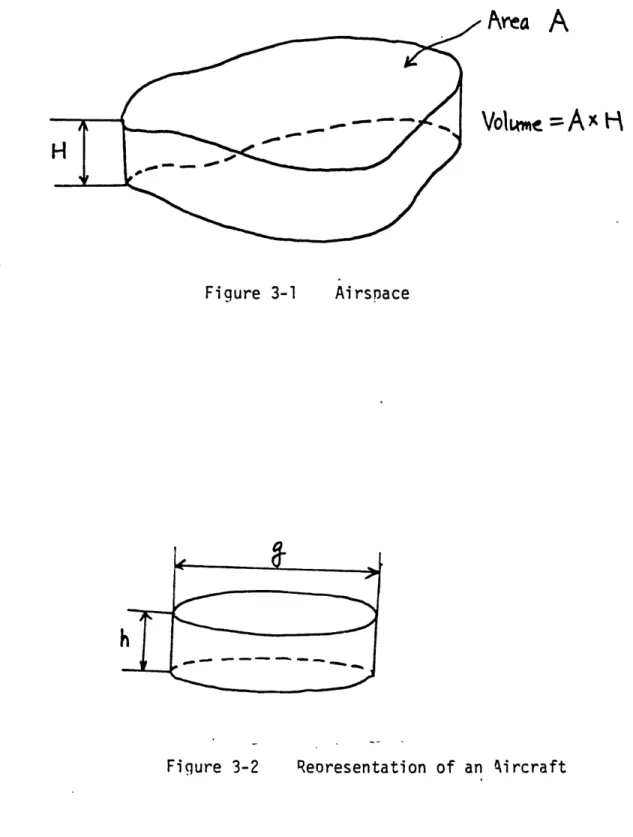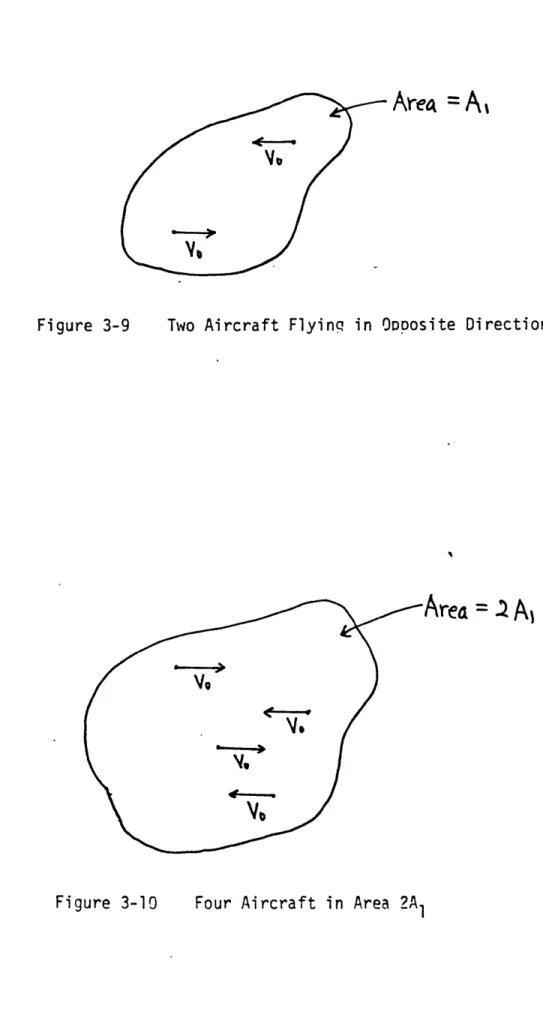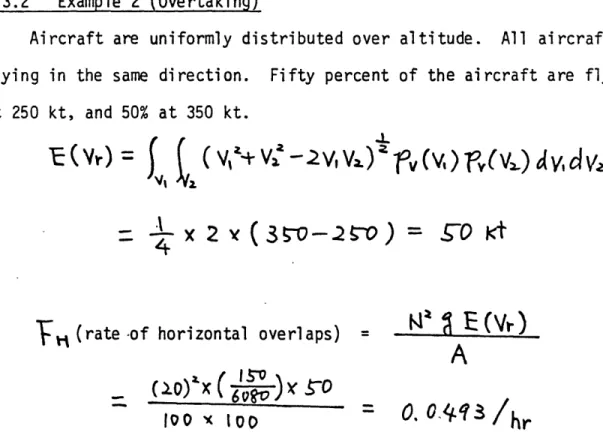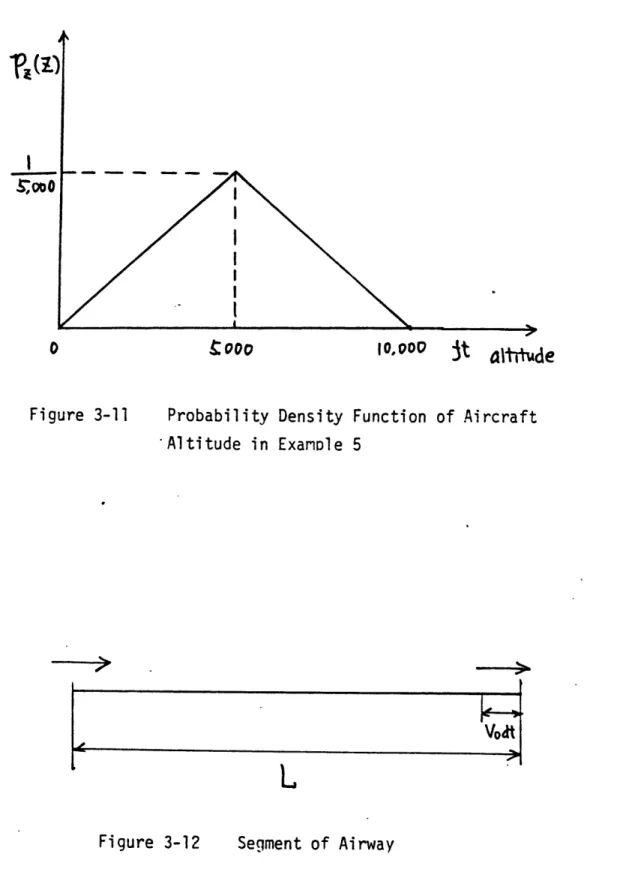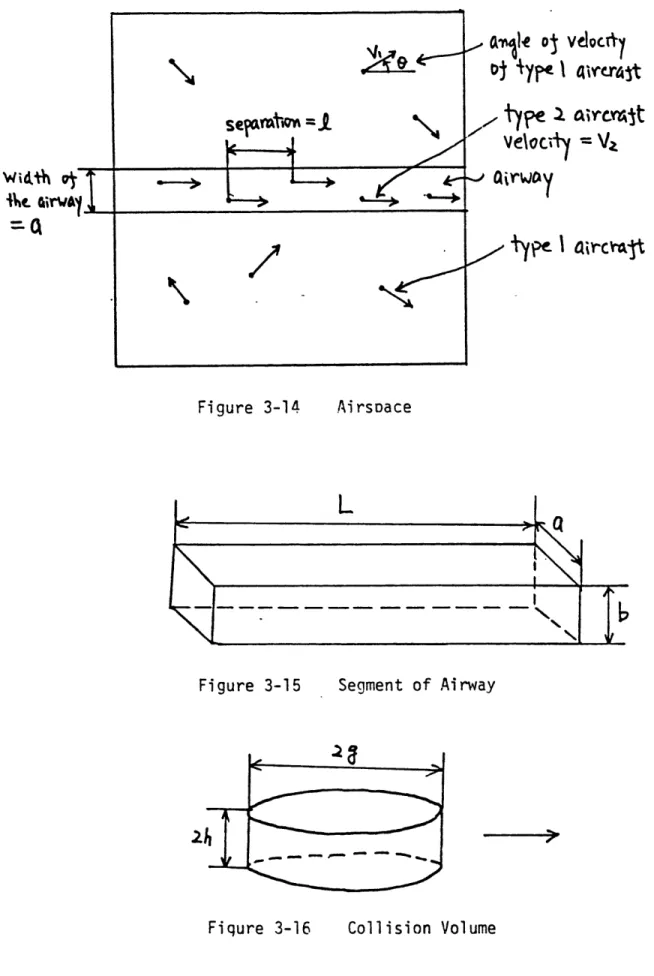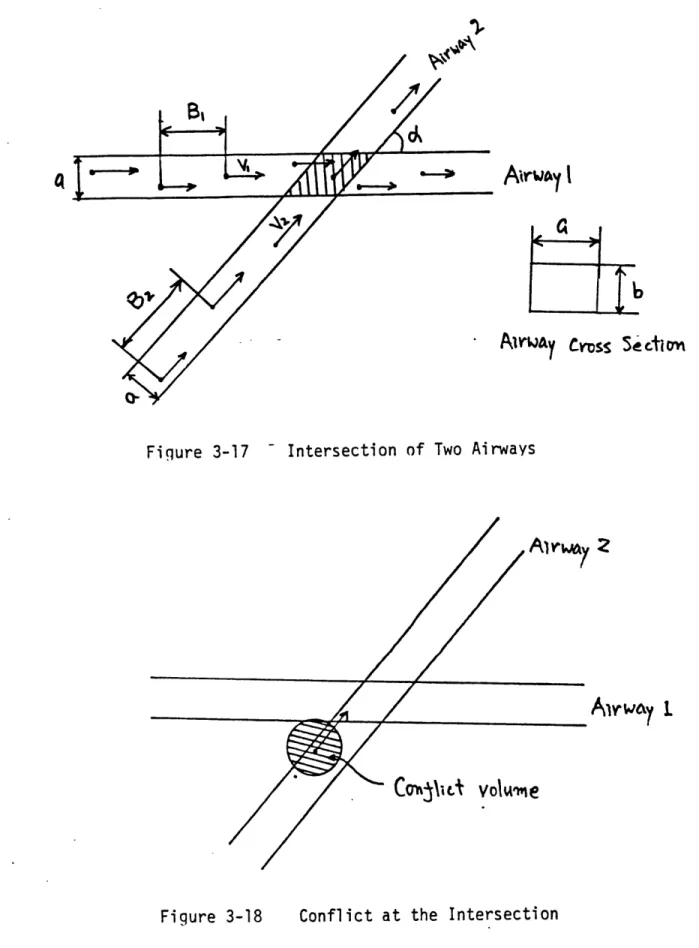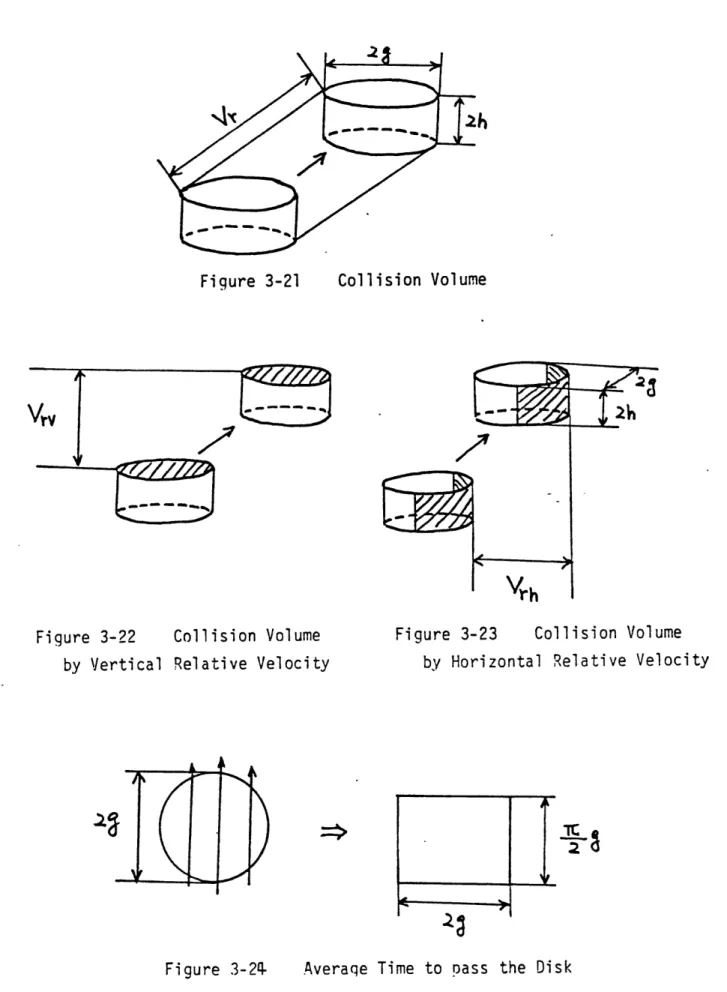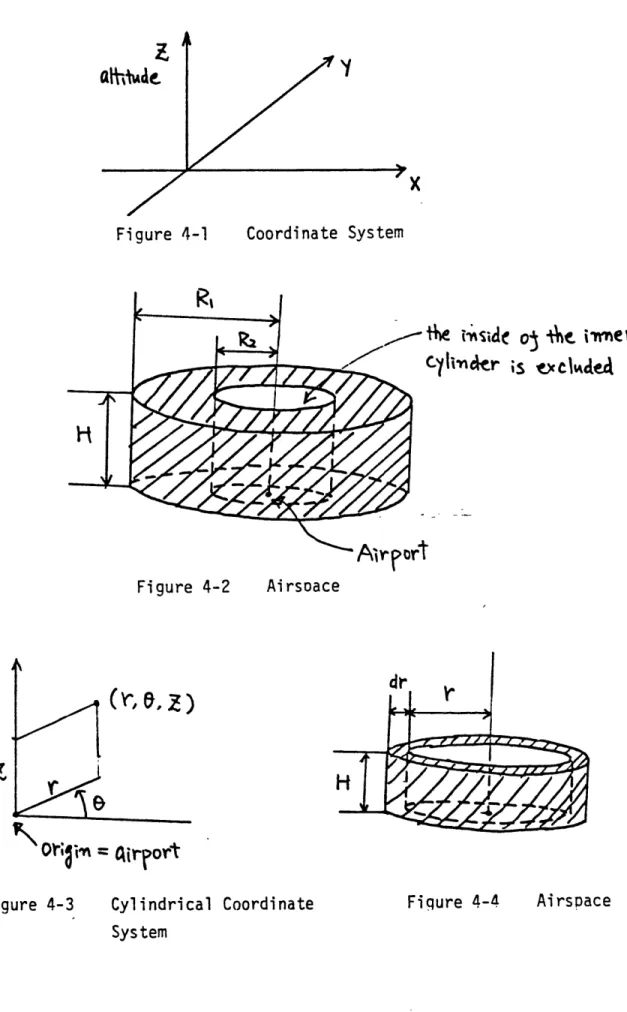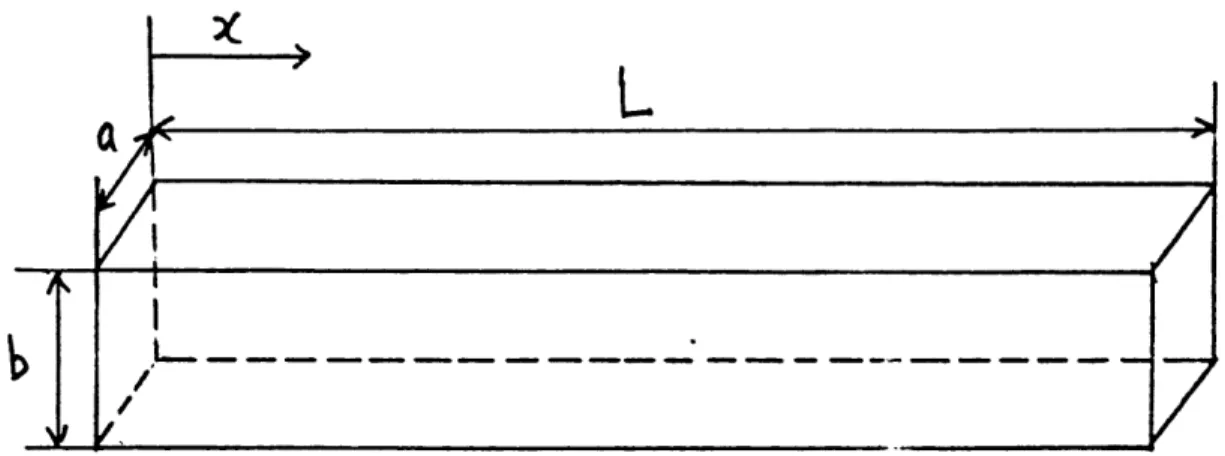FLIGHT TRANSPORTATION LABORATORY REPORT R82-2
AIRCRAFT COLLISION MODELS
SHINSUKE ENDOH
MAY 19 82-4
FTL REPORT R82-2
AIRCRAFT COLLISION MODELS
Shinsuke Endoh
Flight Transportation Laboratory
Massachusetts Institute of Technology
Cambridge, Massachusetts 02139
-TABLE OF CONTENTS
Chapter Paqe
1 INTRODUCTION 5
2 AIRCRAFT COLLISION MODELS 7
2.1 The Reich Model 7
2.2 The Gas Model 13
3 SOME EXTENSIONS OF THE GAS MODEL 15
3.1 Generalized Two-Dimensional Gas Model 15 3.2 Expected Relative Velocity 25
3.3 Special Cases 31
3.4 Overtaking 40
3.5 Probability Pensity Function for the Direction 43 of Aircraft Which Maximizes the Collision Rate
3.6 Probability -f Vertical Overlap 48 3.7 Collision Rate between VFR Aircraft and 51
Aircraft on n Airway
3.8 Collision Rate at the Intersection of Two Airways 55 3.9 Three-Dimensional Gas Model 61
4 TERMINAL AREA COLLISION MODEL 68
4.1 Special Cases: Collisions between the Same 71 Type of Aircraft
4.2 Special Case. Collisions between Two Different 77
Types of Aircraft
4.3 The Upper and Lower Bounds on the Collision Rate 79
5 CONCLUSION 83
REFERENCES 86
APPENDIX A 88
5
CHAPTER 1 INTRODUCTION
The threat of midair collisions is one of the most serious problems facing the air traffic control system and has been studied by many
researchers. The gas model is one of the models which describe the expected frequency of midair collisions. In this paper, the gas model which has been used, so far, to deal only with simple cases is extended
to a generalized form, and some special types of collision models, such as the overtaking model, are deduced from this generalized model. The
effects of the probability distributions of aircraft direction and altitude on the frequency of collisions are also analyzed.
The results in this paper can be applied to evaluate the frequency of conflicts as well as that of collisions. In this paper, an aircraft is represented as a circular cylinder, and a collision is described as an overlap of two cylinders. If the size of the cylinder is expanded
to the volume of the protected airspace of an aircraft, an overlap of two cylinders means a conflict. Therefore, with a slight modification,
the results can be used to analyze the frequency of conflicts. This flexibility gives the models of this paper an important potential for application to a future air traffic control system. The FAA is currently developing a new type of air traffic control system called AERA (automated en route air traffic control). AERA is expected to reduce the workload of human controllers and expand the capacity of airspace using new computer systems and better communication links. When this system is fully implemented, aircraft will be able to fly under
the frequency of potential conflicts the computer system should handle becomes high. Therefore, the frequency of potential conflicts under various circumstances should be calculated in order to estimate the computer workload before full implementation of the system. The models
developed in this paper may be helpful in this evaluation.
The consequences of actual collisions are, of course, grave.
Fortunately, the average number of such collisions per year has remained
relatively small. According to an FAA Report (Report of the FAA Task Force on Aircraft Separation Assurance, Jan. 1979), the average number-of midair collisions reported to NTSB from 1974 through 1978 was 33 per year. Most midair collisions have occurred between small general aviation
aircraft operating under VFR. However, the report also states that there were 227 near midair collision reports in 1975 alone, and that air
carriers were involved in 68 of these cases. (According to the report, a near midair collision is an incident which would probably have resulted in a collision if no action had been taken by either pilot. Closest proximity of less than 500 ft would usually be required for a near midair collision report.) Although the number of conflicts is not available in the report, it is clearly far greater than the number of near midair collisions considering the difference of airspace volumes involved.
The outline of this thesis is as follows. In Chapter 2, we present an overview of two aircraft collision models, the Reich model and the gas model, which have been the most important ones in this field. In Chapter 3, we develop some extensions of the gas model including a generalized two-dimensional gas model, an overtaking model and a three-dimensional gas model. In Chapter 4, we develop an aircraft collision model which does not assume the uniformity of aircraft distribution. The conclusions of this thesis are summarized in Chapter 5.
CHAPTER 2
AIRCRAFT COLLISION MODELS
In this chapter, an overview of the Reich model is first presented, and then the gas model is briefly described. These models have been
the most important ones in estimating collision risks.
2.1 The Reich Model
Many models have been developed to estimate aircraft collision rates under various circumstances. Probably the best-known among them is the Reich model which was employed to assess the collision risk to flights over the North Atlantic Ocean as part of efforts to reduce the lateral separation between North Atlantic air routes.2,3
In the Reich model, an aircraft is represented by a box,, and a collision is described as an overlap of two boxes. The occurrence of this overlap is equivalent to the event that a point enters a box which has dimensions twice as large as those of the original box.
The collision rate is expressed as
-
1,Xt
FY -t-
Yy jz,(
(2-1)where
is the expected frequency per unit of time with which the along-track separation shrinks to less than
.x.
and E are similarly defined.
is the probability that the along-track separation is less than K at a random instant of time.
VI
Model of Collision
V2
Oe
If we are calculating the collision rate between a pair of aircraft assigned to the same flight altitude and flying on parallel flight tracks separated by the lateral separation S Y , (2-1) becomes
FX Py (SY) P'
(0)
?
{()(
y)
-yO
( )ZP(0)
(2-2) wherePy(s,)
is the probability that the across-track separation between a pair of aircraft, nominally spaced at the lateral standardseperation S, , is less- than 1y .
j(0) is the probability that the across-track separation between a pair of aircraft, assigned to the same track, is less than
(s)
is
the expected frequency per unit of time with which the
across-track separation between a pair of aircraft, nominally spaced at the lateral standard separation , shrinks to
less than Xy .
O') is the expected frequency per unit of time with which the
across-track separation between a pdir of aircraft, assigned to the same track, shrinks to less than
P
(0)
and(
are similarly defined for the vertical dimension.If aircraft on the same track are spaced with the along-track
separation ,
5x
and,
where
X
is the relative along-track velocity of a pair of aircraftE,(o)
and FX(O) depend upon the vertical dynamics and vertical station keeping of aircraft. Reich presented numerical examples for(D)
and(0)
in his paper. They are0z()
=
40/
~hr0)
= 0.26
can be calculated if the probability distribution for the lateral deviation of aircraft from the center line of the track is known.
_PY(Y)(2-4)
where
f(y)
is
the probability distribution of lateral deviation of
aircraft from the center line of the track.
T(y) is estimated through the first Laplacian distribution.
Fz V-2(2-5)O
where
G\ is the standard devaition, and is the mean of lateral
deviation.
Ty
(Sy)
=
EC
Py
F(Sy)
(2-6) whereis the relative across-track velocity of a pair of aircraft. This completes a brief mathematical description of the Reich model. This model was employed to estimate the collision risk to flights over the North Atlantic Ocean in the 1960's. The number of flights over the North Atlantic Ocean increased dramatically in the 1950's and the early 1960's, and the traffic became seriously congested by the mid-1960's. The lateral separation between the center lines of adjacent air routes over the North Atlantic Ocean was 120 n.m. at that time, and the airlines
suggested thatthe lateral separation be lowered to 90 n.m.. The FAA agreed with the suggestion, and ICAO adopted it. However, airline
pilots were strongly against it, and the separation standard tentatively returned to the 120n.m. standard as a result of a hearing. Then the
study of the collision risk over the North Atlantic Ocean started. First data for lateral deviation from the center line of the air route were collected through the use of radars on land and on ships. Then the collision risk was determined using the Reich model. The conclusion was that the lateral collision risk at 90n.m. lateral separation was
about six times a great as at 120 n.m. separation. It also became obvious that the. lateral collision risk far exceeded the risk of collisipn with
one's vertical and longitudinal neighbors.
The final solution to this
problem was what is called staggered separation which is shown in
Figure 2-2,
Iatel seratio-n) /2 -"i77
~,ooo~t
Conventional SeoarationQuo
it 000 t Staggered SeparationConventional Separation and Staggered Seoaration
Figure 2-2
risk over the ocean. Some more recent studies have attempted to estimate the collision risk to continental flights. Polhemus and Livingston
collected data for lateral deviations of aircraft flying in the VOR airways system.4 They concluded that the deviation distribution varies considerably with position with respect to the VOR. Based on this data, Polhemus calculated the collision rate of aircraft flying on two parallel air tracks within the VOR system.5
2.2 The Gas Model
Another well-known collision model is the gas model. The reason for this name is that its basic concept is essentially the same as that of a gas molecular collision model. A brief description of the two dimensional gas model is given below, and the generalized gas model will be developed in Chapter 3.
The two-dimensional gas model assumes that N aircraft operate in an area A. Each aircraft i, travels in a straight line with velocity
Vi, and direction distributed uniformly between 0 and 27T. Aircraft are uniformly and independently positioned over A.
The magnitude of the relative velocity of two aircraft i and j, is
Vr;
(vvi
ik~()
(2-7)
where
Vrii
= relative velocity of two aircraft i andj.
(3
= relative directional angle of the two aircraft. If an aircraft is represented as a disk with diameter g, theprobability of a collision between i and j during a period of time t is given by
El
2-5
Vr;ij
(2-8)
A
If
E\Vr
is the expected relative velocity, the expected number of collisions during a period of time t isH
22g E~y)
t
2
z
A
A
E(2-9)
In a three-dimensional problem, (2-9) gives the number of horizontal overlaps during a period of time t assuming that aircraft are flying
only horizontally. If the traffic density is uniform in an altitude layer
H thick, and an aircraft has the vertical dimension h, then the
three-dimensional collision rate can be obtained by multiplying (2-9) by
H-This model has been used to estimate the collision rate in terminal area.6,7 In reference 7, Flanagan and Willis developed a three-dimensional
gas model which allowed aircraft to have a vertical velocity component as well. However, this model assumed that directions of aircraft velocity are randomly distributed over three-dimensional angle. This assumption
is obviously unrealistic because airplanes do not have the capability to fly vertically like helicopters.
The gas model described above can deal only with simple cases. In the next chapter, the gas model is extended to a generalized form, and
the probability distributions of aircraft direction and altitude are analyzed in connection with the collision rate.
CHAPTER 3
SOME EXTENSIONS OF THE GAS MODEL
Some extensions of the gas model are presented in this chapter. First, a generalized two-dimensional gas model is developed. Then, the definition of expected relative velocity is examined, and some special
cases are analyzed. The overtaking problem is briefly discussed as a
special case of collision. The horizontal overlap rate and the proba-bility of vertical overlap are also discussed. Finally, a three-dimensional gas model is developed.
3.1 Generalized Two-Dimensional Gas Model
This model assumes that N aircraft are flying in the volume with
horizontal area A and height H (Figure 3-1).
Horizontally, aircraft are uniformly and independently distributed, and vertically, they are independently but not necessarily uniformly distributed. The horizontal distribution and the vertical distribution are independent of each other. All the distributions in this model are time-invariant. The assumption that the density of aircraft is time-. invariant can be justified considering that the collision rate is small and so is the rate of aircraft loss.
Each aircraft travels only horizontally. It is not assumed that each aircraft travels only in a straight line. No collision avoidance maneuver is taken, however. The assumption of no collision avoidance maneuver is obviously not realistic, and leads to an overestimated collision rate. However, as explained in Chapter 1, with a slight modification, the rate of conflicts can be calculated under the same
16
-Area
A
Figure 3-1 Airspace
Reoresentation of an Aircraft Figure 3-2
assumption, and that rate may be helpful in
estimating the workload of
pilots and air traffic controllers in
avoiding conflicts. Therefore, the
result with this assumption may be useful both in
obtaining a conservative
estimate of the collision rate and in
estimating the workload of pilots
and air traffic controllers in preventing collisions.
Each aircraft is
represented as a right circular cylinder, shown
in
Figure 3-2. A collision is
described as an overlap of two cylinders.
The occurrence of this overlap is
equivalent to the event that a point
representing a center of one aircraft enters the cylinder of another
aircraft which is
twice in
length and eight times in
volume as large
as the original aircraft (Figure 3-3).
The
collision rate is
expressed as follows.
C
TH XP
(3-1)
where
= the rate of collisions per unit of time
= the rate of horizontal overlap per unit of time
= probability that two aircraft overlap vertically given they overlap horizontally
= P (vertical overlap/horizontal overlap)
Horizontal overlap means that, neglecting the vertical axis, the horizontal coordinate of the center of one aircraft enters within a range of g from the horizontal coordinate of the center of another aircraft (Figure 3-4). Vertical overlap is similarly defined.
Let us consider
P,
first.
Collision Volume
Horizontal Overlap Figure 3-3
of aircraft,
Pv
VertieW\
overtoA
jor
tw
Aircrat)
(3-2)Let (Z) be the probability density function for the altitude of aircraft.
f
)dz
is
the probability that an aircraft isflying at an altitude between
Z
and Z - Then, 4tHivPy
=I
VC;
~c~ddu d
(3-3)where G is the altitude of the lowest surface of the airspace under consideration.
Let us calculate
H
0
Crttj1(i
for the uniform
(Z)
Otherw/ise,
2h
H
- hz
If H >> h, then
.2h
1-1 (3-4)This shows that if aircraft are uniformly distributed over an altitude layer H, with H much greater than the aircraft height h, the collision rate is approximately
Next, let us consider the rate of horizontal overlap Tl . As explained earlier, a horizontal overlap takes place when the center of an
Ade
CT
rovP
Figure 3-5
.,V
At
Vertical Overlao - -
-Execded
-numbr
og akta&t
9S e4
=
SxHorizontal Overlap in dt Figure 3-6
aircraft enters within a range of g from the center of another aircraft.
Let
E(\r)
be the expected relative velocity. Then, during a very
short period of time
dt
, each aircraft encounters
.2.1
(Vr)cit
f
overlaps on the average, where
I
is the horizontal density of
aircraft.
Since is N/A and there are N aircraft, the total number of
horizontal overlaps in dt is
Ix six
(2
E(r
tX
A
(3-5)The reason for the multiplier 1/2 in (3-5) is that each overlap would otherwise be counted twice. Then,
H
A
F(3-6)
From (3-1), (3-3) and (3-6), the collision rate is
C
N- _ _ E(rC-_A
EVr)
)
(3-7)
where
C = collision rate per unit of time
A = horizontal area of the airspace under consideration
G = altitude of the lowest surface of the airspace
G + H = altitude of the highest surface of the airspace
N number of aircraft in the airspace
g = horizontal dimension of aircraft
(,
NO= expected relative velocity
= probability density functipn of altitude of aircraft
If aircraft are uniformly distributed over altitude and
(3-8)
Below and in Section 3.3, we shall calculate
EN
)
for some special cases. At this point, we shall assume that each aircraft travels in a straight line. This is to simplify the calculation ofE(Vr)
. Suppose then that two aircraft are flying at velocitiesV,
and \/ ' Then, the relative velocity isV
V,Vj-
2 V Vz t-0
)
(3-9)where
/y.
= relative velocity(S
= relative directional angle of two aircraftThen,
v,4v-y)V,
V((3)
f
(v)vA)c3
AVAvy
2(3-lo)
where
= probability density function of
v)
=probability density function of V
'23
0 and 27(, and the magnitude of velocity is constant,
Z
TG
O
1'<2
7L
Then,
E (Vr)
=
(v"-
1v'
cosp)
dI
.~ALVD
[Numerical Example]
Twenty aircraft are flying in the airspace shown in Fiqure 3-7. Each aircraft is flying horizontally at 300 kt in a random direction. Aircraft are represented by a circular cylinder with diameter of 150 ft.
and thickness of 50 ft. Aircraft are uniformly and independently distributed in the airspace both horizontally and vertically.
-4
(V)Vo
=382
kt
2h
H
.II00
A
=0.31n/
(3-11)
P
.
Figure 3-7
-Are4 =
oYxiol
=
QiJc t Nuvber og aircatFigure 3-3 Collision Rates in Different Areas ID.Qk
This may seem surprisingly large. This is
because the expected
relative velocity is
large in
this case.
3.2
Expected Relative Velocity
A brief discussion of the meaning of "expected relative velocity" will
be useful at this stage. It
seems simple at first to define the expected
relative velocity. However, the concept creates some difficulty in
estimating the collision rate in
the gas model. For simplicity, only
two-dimensional problems are dealt with in
this section.
It
is
sometimes maintained not only in
the field of air traffic
control
6but also in
the field of statistical mechanics
8that the collision
rate is given by the following formula
N(N-
I)
2$E
1(Vr)
C
.
A
(3-12)
2
A
where
E
r)
is
the expected relative velocity taken over all
possible pairs of aircraft. This equation is
different from (3-6), which
uses as its first term. If we are dealing with molecular collisions, N is a very large number and the difference between the two formulae is very small. Therefore, there is no practical problem in that field. But, in the case of aircraft collisions, the difference
may be of some
significance as the density of aircraft is
usually low.
We shall discuss the difference between the two formulae below.
El _______
pair of aircraft will meet each other during a very short period of time dt is
2a
E'Cv)
ct
. Since there are N aircraft,there are KI(N- I
A
possible pairs of aircraft. Then, the expected2
. _____-2~.'61t )dt
number of collisions during dt is
A
Therefore, the collision rate is given by (3-12).
Let us assume, at first, that (3-12) gives the correct collision rate.
Consider the situation shown in Figure 3-8. Suppose that there are M aircraft in the large area (10 1 x l0Q.) and the probability
distribution for the position of each aircraft is uniform over the area. The expected number of aircraft in the small area (kxk) is . Let us
calculate the two collision rates in the large area and in the small area. According to (3-12), the collision rate in the large area L is given
by *
CL-
M(
-v))
(3-13)
Similarly, the collision rate in the small area is
S
2.(3-14)
Since the large area can be sub-divided into 100 small areas,
CL
shouldbe 100 times as large as S . However,
_ 00 _ v D__ i a
'(W)
(3-15)z
100ok
Then,
This is a contradiction. The explanation for this contradiction lies in the definition of the expected relative velocity
(Vr)
In (3-13) and (3-14), it is implicitly assumed that E'(Vr) is the
-same in
both areas. But
E(\r)
is
a function of N if
we are to
use (3-12).
E'(Vr)
in (3-12) is the expected relative
velocity taken over
all possible pairs of aircraft. Therefore, if
the number of aircraft
changes, so does 'E(Vr) . In order to make this problem clear,
let us consider some examples.
Suppose that two'aircraft are flying in opposite directions at speed
V
The probability distribution of their positions is uniform over the areaA,
(Figure 3-9). The number of possible pairs is one,and
(v\/.)
is
l2fV
.The collision rate is given by (3-12).
2
A,
4t Vo
Next, suppose that four aircraft are flying at speed
"o
in thearea . . Two of them are flying in the same direction, and the
other two are flying in the opposite direction. The probability
distribution of their positions is uniform over the area (Figure 3-10). is defined as the expected relative velocity taken over all possible pairs aircraft. Viewed from any one of the four aircraft, two other aircraft are moving at speed 1V, and the other one is
Area =
A,
Figure 3-9 Two Aircraft Flyinq in OpDosite Directions
=.2
A,
Four Aircraft in Area 2A1 Figure 3-10
2V6tVO
+
4VO
(3-18)3
3
This value is different from
E(Vy)
in (3-17), although the probability distribution of directions of velocity is the same in both cases. The collision rate in this case isN(N- 2a E'vt
.2
l
-
- ,
-
(
3
-1
9
)
2ZAi
A,
Therefore, the collision rate in the area : is twice as large as
the collision rate in the area A,,
These examples show that .'(Vy) , which is defined in (3-12) as the expected relative velocity taken over all possible pairs of aircraft, is a function of the number of aircraft. Next, the relation between
E(Vr)
in (3-6) and V(Vr in (3-12) is analyzed,and the mathematical expression for
E'(/r)
in terms ofE()
is derived. is defined as follows .E(v)
~
V
-Vi
\T( )
)
ddV
(3-20)
where= velocity vector of aircraft i
= probability density function of velocity vector Let us calculate the average relative speed based on (3-20).
Suppose that there are N aircraft, and aircraft i has the velocity
vector \. . Then, the average relative velocity is
\
- \
(3-21)
However, the average relative velocity taken over all possible pairs of aircraft, which is defined as , is
- . (3-22)
Since
-
0
,(3-22)
becomes
L\
)(3-23)
Then, - _ _ ( 3 - 2 4 )N
-Therefore, if the expected number of aircraft is N(N
>
1), therelation between f(V,') and is as follows.
N
\/y)
(3-25)where
£(Vr) = expected relative velocity defined by (3-20)
= expected relative velocity taken over all possible
pairs of aircraft
Therefore, (3-6) and (3-12) used in this way give the same collision rate.
The reason for the difference between
E(Vy.)
and
5(/r)
is that
when VV. is averaged over all pairs of aircraft, all pairs do not include the pairs consisting of an aircraft paired with itself.Let us examine the difference between and in the examples shown in Figure 3-9 and 3-10. \ in Figure 3-9 is
tIr
whereas
The collision rate in Figure 3-9 is
C =
z
Ai
laVO 41V,
This is the same as (3-17).
The collision rate in Figure 3-10 is
-N
2W
Z
A
2.Ai
At
This is the same as (3-19).
These examples show that EL'(Vr) is a function of the expected number of aircraft. If this fact is recognized; the formula
2N
2-a E'(v)
2
A
offers no problem. However, thisfact has been overlooked in the past in using the formula, and it is
inconvenient to use
E'(Vr)
becauseF(V,)
is a function of theexpected numbers of aircraft. Therefore, from now on the preferred
iN
E(Vr)
formula
()
A
N(04-1)
.A ETVO )
2
A
rates in this paper.
3.3
Special Cases
will be used (and
1 not be used) to estimate collision
The gas model developed by Graham6 and Flanagan7 assumes that
directions of aircraft velocity are uniformly distributed between 0
and
(3-26)
21(,.[see
also (3-11)]. However, this assumption is not necessarily a goodone because destinations of aircraft are not uniformly distributed. In this section, the general formula for the collision rate for non-uniform probability distributions of aircraft direction is developed, and the collision rates for constant velocity (i.e., for when the
magni-tude of velocity is constant) are calculated for some special
distributions of aircraft direction. Some numerical examples for cases in which the magnitude of velocities is a random variable are also given.
The general formula for the collision rate is given by (3-7).
C
A7(Z)
(3-7)
where
= directional angle of velocity of aircraft i
= magnitude of velocity of aircraft -i
- = probability density function of G
=probability density function of
V/
The collision rate for any distribution of direction and magnitude of aircraft velocity is given by (3-7) and (3-28).
We calculate first the collision rate for constant velocity (the magnitude of aircraft velocity is constant).
Suppose that the magnitude of aircraft velocity is a constant Then,
2 VO
E(
(96)2
(3-29)
0
E(vr)
for some special probability density functions ofdirection is tabulated in Table 3-1. It is assumed that horizontally aircraft are Uniformly distributed. The corresponding collision rate is given by (3-7). If positions of aircraft are uniformly distributed over altitude and the height of aircraft is negligibly small compared with the thickness of the altitude layer under consideration, the corresponding collision rate is given by (3-8).
A
(3-8)For distributions other than the uniform vertical distribution, the collision rates can be calculated numerically.
Table 3-1 shows the values of the expected relative velocities for
some interesting probability density functions of velocity direction. For example, the third case in Table 3-1 is the one in which a fraction K of aircraft are flying in the same direction, while the directions of
the other (1 - K) fraction are uniformly distributed over 0 and .27.
In the fourth case, aircraft are flying only in two directions.
Table 3-1 shows E(Vr) only for the cases when the magnitude of the velocity is constant. If the magnitude of velocity is a random variable,
Expected Relative Velocity
e~Lo
( ) vI = constant)
Tabl e 3-1
00
e d
*)
S
(0) is
Ane Adtt
ito-n
35
[Numerical Example]
We now illustrate these results through numerical examples: assume
that 20 aircraft are flying horizontally in the airspace shown in
Figure 3-7. Each aircraft is represented by a circular cylinder with a
diameter of 150 ft. and a thickness of 50 ft.
3.3.1 Example 1
Aircraft are uniformly distributed over altitude. All aircraft are
flying in the same direction and at the same velocity.
E (V )
=
0
C(~)
0
C
(
colhsio,
rcte)
=0
3.3.2 Example 2 (Overtaking)
Aircraft are uniformly distributed over altitude. All aircraft are
flying in the same direction. Fifty percent of the aircraft are flying
at 250 kt, and 50% at 350 kt.
"E
(Vr
(,
V -V, V2.),2f
V
(v)f
y(v.)dy, d
x
2
(35--2
)
=
gO kt
-4
M*3
N(r)
(rate
-of horizontal overlaps)
=A
oo
x =oo0-.
04-3/hr
V (probability of vertical overlap) 2.
I
0 0
2H
H
C (collision rate)4.13
x
\0~4/r
= 1 collision/2,027 hours(The overtaking problem can be treated as a special case of the
generalized collision problem. A brief discussion will be presented in the next section.)
3.3.3 Example 3
Aircraft are uniformly distributed over altitude. aircraft velocity are uniformly distributed over 0 a
Directions of nd 2T% . Fifty
percent of the aircraft are flying at 250 kt, and 50% at 350 kt.
COs ()X tx (,v)
r(v2.)
dc
a
VdV
2is relative directional angle of velocity) 1
4 x
2-0
I
4-~
U
If
-4x
3S-50 - l-x33py.)30 x Coys
= 389 (this integral is numerically calculated)
VE
l
~-
4
0
X,
x ?v
(V4i-V
- V,
V,
A
1.10fx
3L
x
to0=
0.1%4
10o3.84
xK
10
/h,
3.3.4
Example 4Aircraft are uniformly distributed over altitude. Directions of aircraft velocity are uniformly distributed over 0 and llL. Magnitudes of aircraft velocity are uniformly distributed over 250 kt and 350 kt.
3Q 50 C
v,
2S
."
0.vt
= 384 (this integral is numerically calculated)
N
E(Vr)
T.
A
(20)xc
(IS
)X384
100
x
100
FE NV)
\00
x
I I I AVIAV, -IMC
too
'
I0 0
3.11 x
=0
3.3.5 Example 5
The probability distribution of aircraft altitude is triangular as shown in Figure
Example 4.
\0,000
?V
3-11. The other assumptions remain the same as in
S. 10,000 \00 is the same as ~rzzcz in Example 4.
5.05
x
I(
-/
~(z)
P7
(dA
av Az
/
7
5-= T" x ?v
0
t
000
Figure 3-11 Probability Density Function of Aircraft Altitude in ExamDle 5 Segment of Airway 1, 411,1, d, 611, , wl"11WO14111kilim HINHIII 111110 S;000
10,000
it
tid
Figure 3-123.4 Overtaking
The overtaking problem in which aircraft are flying on a single route but not at the same velocity can be treated as a special case of the
generalized collision problem. Suppose that aircraft are flying on an airway. For simplicity, the width of the airway is assumed to be zero.
Then, the collision rate is the same as the overtaking rate. In this case, the expected relative velocity is
V, -
Val
],) fy(%V 11Vic\/ (3-30)V, V
Let us calculate the overtaking rate within the segment L of the airway, assuming N aircraft are uniformly and independently distributed
over the segment.
~T
=~E
(v)
(3-31)where
T = overtaking rate within the segment L of the airway N = expected number of aircraft within the segment L of the
airway
It should be noted that the probability density function of velocity ?,(V) is defined here in the domain of space. In other words,
if one aircraft is randomly picked up from the airspace at a certain moment, the probability that its velocity is within V and V + dV
is
given by
ry(v) dv
.
If
fy(V)
is uniform between
\y,
and
between
V,
and \,+dV which enter the segment is less than the expected number of aircraft with velocity range betweenVa--
dy
andVZ
which enter the segment. Let
ty(V)
be the probability densityfunction for the velocity of each aircraft entering or departing the
segment. Let us consider the short portion
VqO~t
from the end of thesegment (Figure 3-12). The expected number of aircraft with velocity
range
V
and
VtdaV
in this portion is given by
X
- -
yJ
Y
,
(vo) d
v
(3-32)
During the period of time dt, these aircraft will depart the segment. Then, the expected total number of aircraft departing the segment ...uring dt is given by
N
a
akdt
7VS
ayt(Yo)4VP
(3-33)
where / is the expected number of aircraft entering or departing the
segment during one unit of time.
Since the expected number of aircraft with velocity range \/Q and
V
4V
which pass the end of the segment during dt is given by
(3-32),
Jy
dt
v(v)dV
-
t,(v)dv
=
d
vlj~1
~-L V v(V)dl
VY()(3-34)
T
V
rf
yV i
T~
N(
-T~
QV'(v)dv)
.
I V,
-
--
~.VX
v
V
(V)Vw\e cV
(V,)
jyVV)dV,d
a 2
2L
Vi
v
IV(Vy_
vvd
_,v2
(3-35)2
,
y
V
, ya
When the overtaking rate is calculated, we should recognize which
probability density.function is given. If
1y(v)
is given, (3-30)
and (3-31) should be-used. On the other hand, (3-35) gives the overtaking
rate when
I
is employed.
1Oy(v)
is defined in the domain of
space, whereas -1y(V) is defined in the domain of time. In order to
illustrate the result of this section, a numerical example is presented below.
[Numerical Example]
The probability density function of velocity defined in the domain of space, py(y) is uniform from 200 kt to 300 kt.
y
=
.00.
V
300
0
otherwise
Aircraft are uniformly distributed along an airway, and the expected number of aircraft is 1/10 n.m.
From (3-31), the overtaking rate within a 100 n.m.-segment of the airway is
ago
.3oo-Fx-10-~j--
0-V.
xxy
200
a.oo
43
Next, the overtaking rate is calculated using (3-35).
v(v)
5
v
ey(V)
V y (V)dVV
9
0v
xtoo
From (3-33),K
-+i:
~od 00 From (3-35), 00 300IV,-V-21
V,
V V
X2,
00X
25,000
dv,
dv,
This value agrees with the value by (3-31).
3.5 Probability Density Function for the Direction of Aircraft Which Maximizes the Collision Rate
Assuming that aircraft are flying horizontally and that the density of aircraft is uniform, the probability density function which maximizes
the collision rate is the uniform probability density function between 0 and 27E . In other words, collisions happen most frequently when
destinations of aircraft are uniformly distributed, assuming the density of aircraft is uniform. The proof of this statement is presented below.
Since the collision rate is proportional
E(Vt/)
,the
probability density function for aircraft direction which maximizes
E(V)
gives the maximum collision rate.Let 91
aircraft and
& and(
.S
/ , be the directional angles of velocity of two
the angle between the two vectors (Figure 3-13).
and -
()
are the probabilityis given by
1%(O
±~g)de
* density functions-forS7
(3-36) ( L -(For convenience of calculation,
~e)
J~
Then, ( )
1F'
(Q)
Vr)
is given in terms ofis also defined as follows
0&9
<
IT
(3-37)
(3-38)
ro
(0
)
by
T'O
w3P1V(Vi)
y(w£)
dVdV.,
Let us examine Since (' has a cycle of ..TL ,
it can be expressed as a Fourier series.
01i
-E~)
(3-lo),
Ve( )
-(0)
V,
0 .6<
4TL
From (3-39) and (3-40), (9) . I t.7m
Then, ItIL(c
± )
03Co's3
From (3-10) and (3-42).(v,) &(V2)dVdIV
ofV
V24v.vV,
c
-Cos
( .
(
Q
ts
n
where (3-39) 2-TL IM IQO
\= 0,\2 (3-40) (3-41) (3-42)E
(VIr )
, v)(0)
Cos
-n\6
dG
r(o) siY\ -no A19
(n, cos v9+6,si-n no)
271L Op
FO (0)
0
(i )W
0 SO <176tU
(Q[
tQ)1
(VAPlvyo
y e (3-43)0
It can be shown that
\
\s
n
(
is always
negative for any set of positive values of
-n , \, OQA
V
The proof
is given in Appendix A. Then,
E
(Vr)
is
maximum when
and
are zeroes for all n. This means that
E(Vr)
is maximum when
1e(e)
=
%:i
From (3-37) and (3-40),
( ::.. .- ~0 L (Cl0 t:5TYi)
0 9<.T,(-44)
If(3-45)
This result may be contrary to our intuition.
It would seem that
if
50% of aircraft were flying in
the same direction and 50% in
exactly
the opposite direction, the expected relative speed would be maximum.
This is
not true, however, because among each 50% of the aircraft flying
If the magnitude of velocity is constant
V
, the expected relative velocity in this case isV
0 , whereas the expected relative velocityfor the uniform distribution of direction is * Therefore, the
collision rate becomes maximum when directions of aircraft velocity are
uniformly distributed between 0 and 17 .
(NOTE) If directions of aircraft are discrete, the probability density
function of
%(p)
consists of impulses.
For example, when 50% of
aircraft are flying in the direction 0=0 and 50% in the direction9
=
L , the probability density function consists of one impulse at=
0
and the other at 9=
T . In this case, f(&) cannot beexpressed as a Fourier series. However, eveni if such cases are
considered, the uniform continuous (not discete) probability distri-bution maximizes the expected relative velocity. In other words, the uniform probability distribution (the probability density function is
between 0 and D76) maximizes the expected relative velocity
for any continuous and discrete probability distributions. The proof is given in Appendix B.
3.6 Probability of Vertical Overlap
The collision rate is given by (3-1) and (3-2).
CH
(3-1)
where
C
= collision rateFH
= rate of horizontal overlapThe maximization of F, was discussed in Section 3.5. In this section,
Py
is briefly discussed.Py
is given by (3-3) (see Figure 3-5). (3-3)C,
-where
= probability density function of altitude of aircraft
h
= height of aircraft= lowest altitude of the airspace under consideration
Ct
H
= highest altitude of the airspace under considerationI-
= thickness of the airspaceIf H
>>
h
andwithin an altitude
can be regarded approximately constant range 2h, PV can be approximated by
?z(Z)
d
Z
(3-46)Through this approximation, it can be shown that the probability of vertical overlap becomes minimum when aircraft are uniformly distributed over altitude.
SA
If
(
)R
Is
p
)
-W~z~~
1
If (Z) ( (3-47) (3-48) 2 ~hI
C-4
-t Vi
pz(u ) 4w dz
) (Fa oo
From (3-47), (3-48) and
(3-49),-Gto
(3-50)
Then,
CA
4(3-51)
V, Therefore, is minimum whenIt is obvious that the probability of overlap is maximum
(
?v
=
)
when the vertical distribution of aircraft is concentrated within the altitude range h. (All aircraft are flying with altitude between
Zo
and Z, *
.)
The result that the probability of overlap is minimum when the distribution of aircraft altitude is uniform contrasts with the result
in Section 3.5 that the horizontal overlap rate is maximum when the
distribution of aircraft velocity direction is uniform. However, this is not a surprising result, intuitively.
51
3.7 Collision Rate between VFR Aircraft and Aircraft on an Airway
So far, collision rates have been calculated for one type of aircraft.
In other words, it has been assumed that all aircraft have the same probability distribution with respect to velocity, direction and space. In this section, a special case of collision between two different types
of aircraft is analyzed. Consider the situation described below. Assume that there are two types of aircraft. Type 1 aircraft are similar to the aircraft which have been analyzed so far. In this section, it is further assumed that type 1 airciraft are uniformly and independently distributed in the airspace. (In Section 3.1, uniformity is assumed only horizontally.) Type 1 aircraft can be regarded as
"VFR aircraft".
Type 2 aircraft are flying on an airway at constant
velocity, and in a direction parallel to the ainay. They are flying at a constant separation distance t from each other (see Figure 3-14).
The expected relative velocity of type 1 and type
2
aircraft,
is then given by
where
VI
= velocity of type 1 aircraftV
2 = velocity of type 2 aircraft = constant=
angle of direction of type 1 aircraft
( 9
=0 in the direction of type 2 aircraft)
~v
(V )=
probability density function of
V,
Figure 3-14 Figure 3-15
ac&le
ol vdocrt
04
ijff
1
41iM41t - type I. arctvelocil = Va
QirwakY,.- type
I
aircm-t
Ai rsoace Segment of Airway Collision Volume Figure 3-16The width of the airway is a, and the thickness of the airway
(the altitude layer in which type 2 aircraft are flying) is b, as shown in Figure 3-15.
Each aircraft is represented as a circular cylinder with diameter g
and height h as before.
The occurrence of a collision is equivalent
to the event that the center of an aircraft enters the cylinder of another
aircraft which is twice in length and eight times in volume as large as
the original cylinder, as explained in Section 3.1. Therefore, thenumber of collisions one type 2 aircraft is expected to have during one
unit of time is the density of type 1 aircraft multiplied by the volume
which the cylinder moving at the expected relative velocity generates
during one unit of time (Figure 3-16).
The volume generated by the movement of the cylinder during one
unit of time is given by
4
3
h
E
(
vrm)
(3-53)Then, the number of collisions one type 2 aircraft is expected to have during one unit of time is
4
1
h
E(Vr),f
(3_54)where
P is the expected number of type 1aircraft in one unit of
volume.
Since there
are
L
type 2 aircraft within the segment
L
of
the airway, the collision rate is
4Th
L.PE(Vrix)
It should be noted that no assumption has been made with regard to the probability distribution of the lateral and vertical position of type 2 aircraft within the airway. The rate of collisions between type 1 aircraft and type 2 aircraft is thus independent of the
probability distribution of position of type 2 aircraft on the cross-section of the airway and the dimension of the airway (C is independent of a and b). The reason is that no matter where a type 2 aircraft is flying, the expected density of aircraft 1 and the expected relative
velocity are constant.
[Numerical Example]
Velocity of type 1 aircraft,
V,
, is constant 300 kt.Velocity of type 2 aircraft,
V
, is constant 300 kt.Horizontal dimension of aircraft, g, is 150 ft. Vertical dimension of aircraft, h, is 50 ft.
Length of the segment of the airway, L, is 100 nm. Separation of type 2 aircraft, I , is 10 n.m.
Density of type 1 aircraft is the same as in Figure 3-7.
(
f2O/
(o0,ooo-n-rn
x
lo,000 jt))
Directions of type 1 aircraft are uniformly distributed between
0 and
2TX.
Then
4h
LP
E(vrix)
=
3'~A'
x
1
3.8
Collision Rate at the Intersection of Two Airways
In this section, we shall discuss the collision rate at the inter-section of two airways. Consider the two intersecting airways shown in Figure 3-17. Both airways have the same width a and the same
height b. The probability distribution of aircraft position on the cross-section is uniform. At first, it is assumed that aircraft on the same airway are flying at the same velocity and with the same
separation. The case in which separations between aircraft are given by Poisson processes will be discussed later. The separations on airway 1 and 2 are
t3,
and k% , respectively. The velocities of aircrafton airways 1 and 2 are
\
and
V
2respectively.
The angle
between the two airways is .Consider one aircraft on airway 2 which enters the intersection shown as the shaded area in Figure 3-17. The expected number of aircraft on airway 1 which the above aircraft encounters during one unit of time
is given by
E
X
(3-56)
B,ab
.
The first term of (3-56) represents the rate of horizontal overlap, and the second term is the probability of vertical overlap, assuming that a and b are sufficiently large compared with g and h which
/
A-trwoy I
CIA
Airway
Figure 3-17 - Intersection of Two Airways
Aiwa4
2
Aiwway
1.
Co-tbid
VolW'Me
Conflict at the Intersection
criOSS Sedici
is
constant and given by
(
y,
X+/2-
-
Cos
j
)
,
(3-56)
becomes4 h
('v-+
Va'-
.
v
o
(3-57)a
b
B,
The expected number of aircraft 2 in the intersection is given by
)( (3-58)
61 B Sim a B, S i-A
From (3-57) and (3-58), the collision rate is given by
h~,+li~ts
Q
4
bVL
Vx -,
Basd
V C(3-59)
6,
BB.
i'ied
This is the collision rate with fixed separations. Next, we shall discuss the situation in which separations between aircraft are given by Poisson processes. Aircraft on airway 1 enter the airway with velocity \/i according to a Poisson process with intensity
X
.and are similarly defined. Then, the .average separations
on airway 1 and 2 are given by
V'
and
-
.Since the two
processes are independent, the collision rate is given by (3-59)
substituting and- for BI and Then, the
collision rate is
4
h
X
,
Xz
(V2+ V2- -AV, Va.tos
d
b , v42 s
i-ya
(3-60)More gnerally, the collision rate at the intersection is given by
4
C
(v
Va
IV,
VX Cos
ek(3-61)
b
0E(8 F
(s8,)
-s
%n
d
where
'(E
)
= the expected separation distance between twoconsecutive aircraft on airway 1
"F )
is similarly defined.It is assumed that the processes of aircraft flows on the two airways are independent of each other.
Section 3.7 and this section have dealt with the rate of collisions between two different types of aircraft. The general formula for these
cases will be derived in the next section.
[NOTE]
In Reference 9, Dunlay developed a conflict model which is similar
to the model in this section. However, there is some difference between the two models. First, the Dunlay model assumes that the width of an airway is equal to zero, which can be treated as a special case of the
model in this section. The second difference concerns the volumes
involved in a collision and in a conflict. A collision is described as an event in which the volume of an aircraft overlaps the volume of another aircraft.. A conflict happens when an aircraft penetrates the
outer surface of the protected airspace of another aircraft. Therefore,
as long as the density of aircraft is uniform in airspace, the rate of conflicts can be obtained from a collision model simply by making the
appropriate change for the volume involved. In the case of the
intersection problem, however, the density of aircraft is not uniform in airspace. Therefore, the collision model in this section cannot be directly applied to the rate of conflicts at the intersection because of the boundary problem (Figure 3-18). However, the rate of conflicts
can be deduced from the collision model in this section.
Consider a portion of the airspace shaped like a parallelogram with the length of a side
L
shown in Figure 3-19. Aircraft fly only in the two directions parallel to the sides of the airspace. The probability distribution of aircraft in the airspace is uniform. L is chosen so large that the diameter of the conflict volume can be regardedas negligibly small. The conflict rate in this case is directly
calculated from (3-61), substituting the dimensions of conflict for g and h. Let us consider the cases shown in Figure 3-20. First all the aircraft flying in one direction are concentrated on an airway parallel
to the aircraft direction.
Since the number of conflicts each aircraft on the airway is expected to have during one unit of time is equal to that of each aircraft flying in the direction in the original case (Figure 3-19).,
the conflict rates in both cases are the same. Next, all the aircraft
in the other direction are concentrated on another airway parallel to the aircraft direction. Since the number of conflicts each aircraft on the second airway is expected to have during one unit of time is the same as in the previous case, the conflict rate of the last case is the same as that of the original case. Then, the conflict rate at the
L
Fiqure 3-19 Parallelogram Airsoace
Equivalent Cases
original case is directly calculated from (3-61). It should be noted that no assumption has been made with regard to the probability distribution of cross-airway position of aircraft. Therefore, (3-61)
gives the conflict rate as well as the collision rate for any
probability distribution of cross-airway position of aircraft. The
result of the Dunlay model can be derived as a special case of (3-61).
3.9 Three-Dimensional Gas Model - -
-So far, it has been assumed that each aircraft travels only
horizontally. In this section, the limitation is removed. The
three-dimensional gas model presented here assumes that N aircraft are flying in the airspace volume B. Aircraft are uniformly'and
independently distributed in the airspace. The vertical velocity and the horizontal velocity of an aircraft are assumed independent of each other. No collision avoidance maneuver is taken. Each aircraft is
represented as a right circular cylinder, as shown in Figure 3-2. It is assumed that this cylinder does not tilt even if its velocity has a vertical component,
A collision takes place when the center of one aircraft enters the cylinder of another aircraft shown in Figure 3-3. Therefore, the number of collisions an aircraft is expected to have during one unit of time
is the density of aircraft multiplied by the volume which the cylinder moving at the relative velocity generates during one unit of time.
Let
V
be the relative velocity.
Vrv
is
the vertical
relative velocity or the vertical component of

